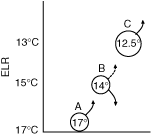Level of free convection — The level of free convection (LFC) is the altitude in the atmosphere where the temperature of the environment decreases faster than the moist adiabatic lapse rate of a saturated air parcel at the same level.The usual way of finding the LFC is to… … Wikipedia
Convection — This figure shows a calculation for thermal convection in the Earth s mantle. Colors closer to red are hot areas and colors closer to blue are cold areas. A hot, less dense lower boundary layer sends plumes of hot material upwards, and likewise,… … Wikipedia
Free convective layer — In atmospheric sciences, the free convective layer (FCL) is the layer of conditional or potential instability in the troposphere. It is a layer of positive buoyancy (PBE) and is the layer where deep, moist convection (DMC) can occur. On an… … Wikipedia
Atmospheric convection — Conditions favorable for thunderstorm types and complexes Atmospheric convection is the result of a parcel environment instability, or temperature difference, layer in the atmosphere. Different lapse rates within dry and moist air lead to… … Wikipedia
Maximum parcel level — The maximum parcel level (MPL) is the highest level in the atmosphere that a moist convectively rising air parcel will reach after ascending through the free convective layer (FCL) and reaching the equilibrium level (EL), near the tropopause. As… … Wikipedia
Convective condensation level — The convective condensation level (CCL) represents the height where an air parcel becomes saturated when lifted adiabatically to achieve buoyant ascent. It marks where cloud base begins when air is heated from below to the convective temperature … Wikipedia
Lifted condensation level — The lifted condensation level or lifting condensation level (LCL), represents the height at which an air parcel being lifted dry adiabatically will become saturated because of adiabatic cooling (caused by expansion) and condense into cloud. It… … Wikipedia
Free surface — In physics a free surface is the surface of a body that is subject to neither perpendicular normal stress nor parallel shear stress,cite web |url=http://www.vishay.com/company/brands/measurements group/guide/glossary/freesurf.htm |title=Glossary … Wikipedia
Rayleigh–Bénard convection — Bénard cells. Rayleigh–Bénard convection is a type of natural convection, occurring in a plane of fluid heated from below, in which the fluid develops a regular pattern of convection cells known as Bénard cells. Rayleigh–Bénard convection is one… … Wikipedia
Cloud — For other uses, see Cloud (disambiguation). Cumulus cloudscape over Swifts Creek, Australia A cloud … Wikipedia
 If a dry mass of air is lifted from A to B adiabatically it will tend to come down from its position B to position A. However, if it becomes saturated at B and rises to C, it will continue to rise.
If a dry mass of air is lifted from A to B adiabatically it will tend to come down from its position B to position A. However, if it becomes saturated at B and rises to C, it will continue to rise.